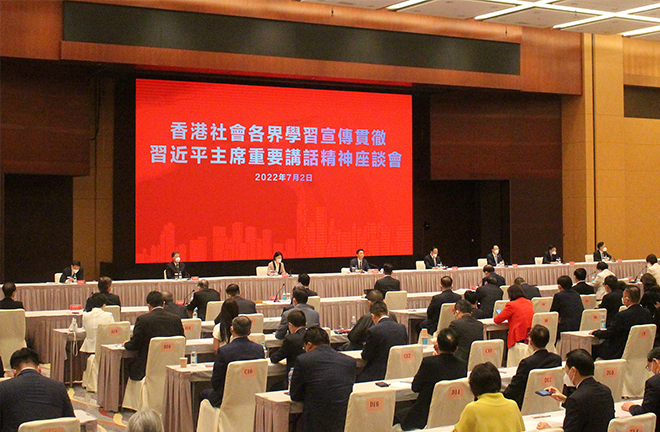
On July 2, more than 200 participants from all walks of life in Hong Kong attend a seminar to learn about, publicize, and implement the spirit of the speech delivered by Chinese President Xi Jinping for the 25th anniversary of Hong Kong’s return to the motherland. Photo: CFP
Scholars have hailed the speech delivered by Chinese President Xi Jinping, who is also general secretary of the CPC Central Committee and chairman of the Central Military Commission, at the meeting celebrating the 25th anniversary of Hong Kong’s return to the motherland and also the inaugural ceremony of the sixth-term government of the Hong Kong Special Administrative Region (HKSAR). The meeting was held on July 1 at the Hong Kong Convention and Exhibition Center.
Over the past 25 years, with the full support of the country and the joint efforts of the HKSAR government and people from all walks of life in Hong Kong, the success of “one country, two systems” has won recognition throughout the world, Xi said.
The fundamental purpose of “one country, two systems” is to safeguard China’s sovereignty, security, and development interests and to maintain long-term prosperity and stability in Hong Kong and Macao. All that the central government has done are for the benefits of Hong Kong and Macao, for the wellbeing of all residents of the two regions, and for the future of the whole country. There is no reason for us to change such a good policy, and we must adhere to it in the long run, Xi stressed, according to Xinhua News Agency.
President Xi Jinping’s important speech reviewed the impressive achievements of the practice of “one country, two systems” in Hong Kong, summarized profound implications of the practice over the past 25 years, and put forward ardent hope for the future of Hong Kong with best wishes, said Chen Shaoling, an associate professor from the School of Economics at Jinan University in Guangdong Province.
Over a quarter of a century, under the principle of “one country, two systems,” Hong Kong, the “Pearl of the Orient,” has shown even more dazzling brilliance. From 1997 to 2021, the value of trade between the SAR and the mainland rose 6.1 times from $50.77 billion to $360.33 billion, an average annual increase of 8.5%. By the end of 2021, investment from Hong Kong into the mainland topped $1.4 trillion. Meanwhile, the mainland’s non-financial direct investment stock in Hong Kong reached $800 billion.
“25 years after Hong Kong’s return to the motherland, Hong Kong’s economy has become more dynamic,” said Shen Minghao, director of the Institute of Studies for the Greater Bay Area (Guangdong, Hong-Kong, Macau) at Guangdong University of Foreign Studies. In 2021, Hong Kong’s GDP reached 2.86 trillion Hong Kong dollars (about $364 billion), and its per capita GDP increased steadily year by year. Its status as an international trade center, financial center, and shipping center is more stable. Hong Kong has developed into a frictionless transit hub and the best international capital pool for the mainland’s international trade in goods, and Hong Kong’s role as a super-connector for trade and investment is even more prominent.
“Guangdong, Hong Kong, and Macao must jointly undertake the important task of creating a new pattern for China’s opening up, so that Hong Kong can better integrate into the overall development of the country,” Shen said.
Han Dayuan, a professor from the Law School at Renmin University of China (RUC) and director of the “One Country, Two Systems” Law Institute at RUC, said that under “one country, two systems,” different legal systems, institutions, and cultures coexist harmoniously, creating a new institutional form for the global rule of law system.
Zhi Zhenfeng, director of the Center for Taiwan, Hong Kong and Macao Studies at the Chinese Academy of Social Sciences, said that for Hong Kong, “one country, two systems” is its biggest advantage, while China’s reform and opening up provides the biggest stage, and national strategies, such as the joint construction of the Belt and Road and the construction of the Guangdong-Hong Kong-Macao Greater Bay Area, present major new opportunities.
Edited by CHEN MIRONG


 PRINT
PRINT CLOSE
CLOSE